Analysis of Gender, Intersectionality, and Educational Experience
VerifiedAdded on 2023/06/15
|7
|2104
|164
Report
AI Summary
This report examines the multifaceted impact of gender and intersectionality on educational experiences, addressing disparities and barriers faced by women, particularly in STEM fields. It discusses concepts like the glass and concrete ceilings, which hinder women's advancement, and analyzes the challenges arising from gender discrimination and societal expectations. The report highlights the educational and professional barriers, referencing Heidi Safia Mirza's study on black women and exploring the unique challenges faced by minority women in education and other domains. It concludes by emphasizing the importance of understanding intersectionality to promote equity and inclusion in education and beyond. Desklib provides resources like this report to aid students in their studies.
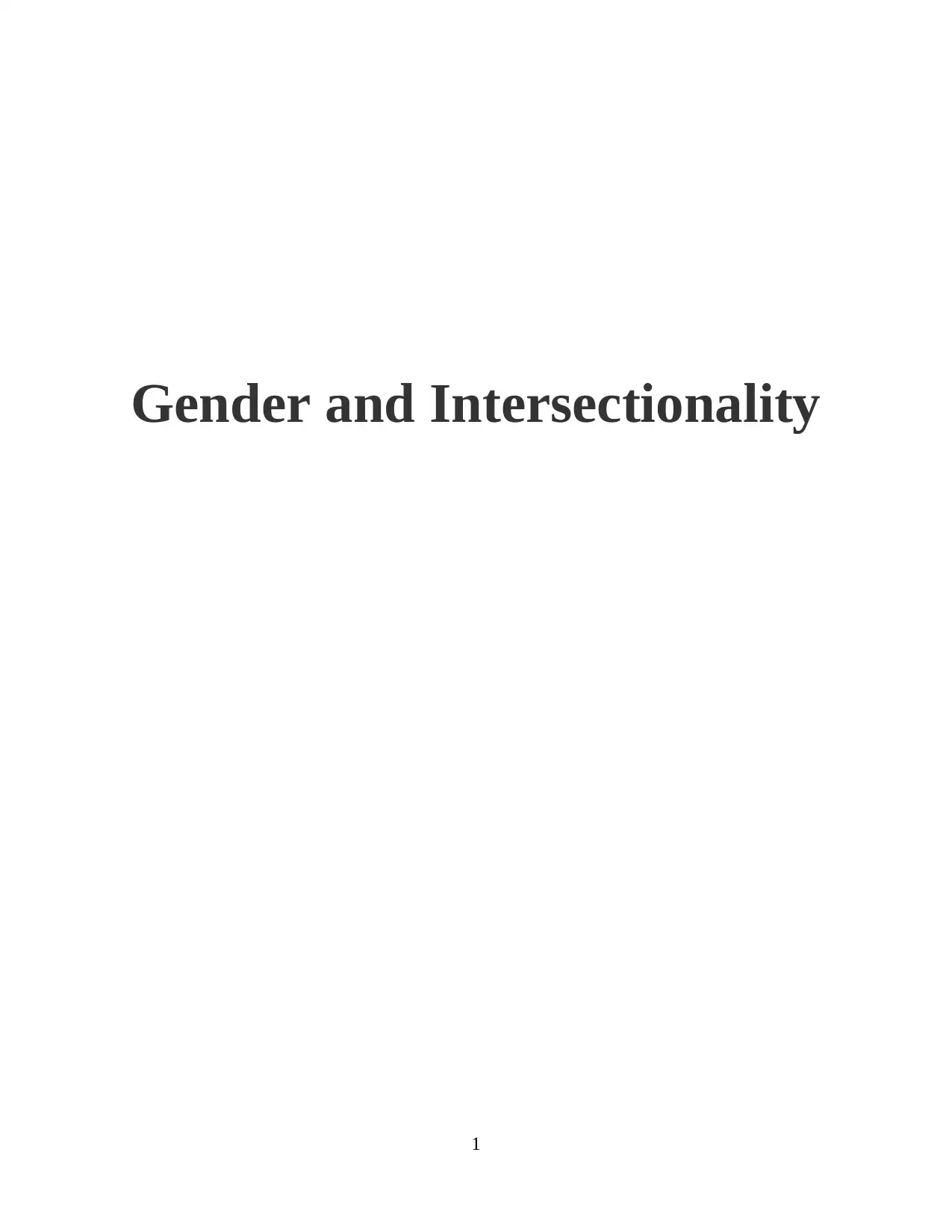
Gender and Intersectionality
1
1
Paraphrase This Document
Need a fresh take? Get an instant paraphrase of this document with our AI Paraphraser
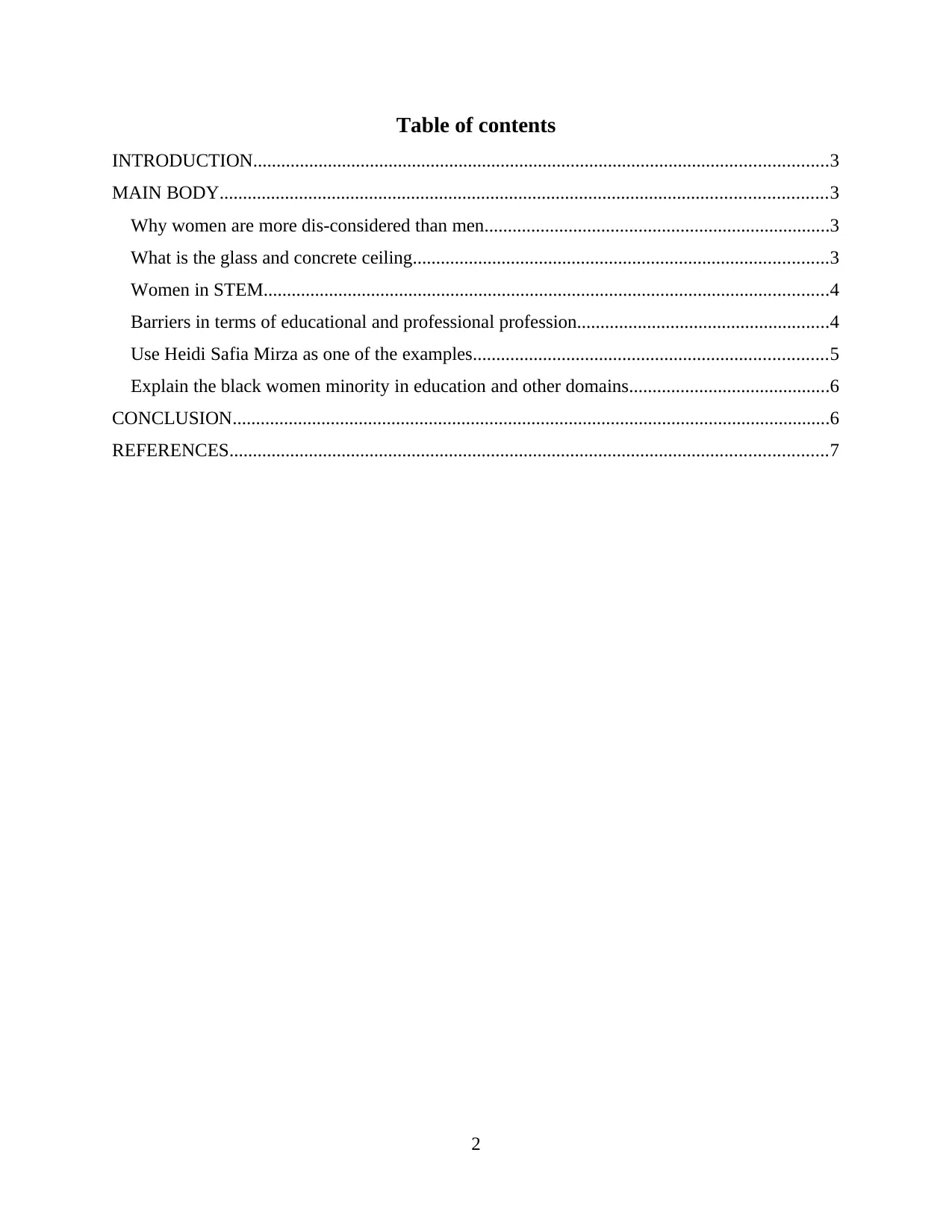
Table of contents
INTRODUCTION...........................................................................................................................3
MAIN BODY..................................................................................................................................3
Why women are more dis-considered than men..........................................................................3
What is the glass and concrete ceiling.........................................................................................3
Women in STEM.........................................................................................................................4
Barriers in terms of educational and professional profession......................................................4
Use Heidi Safia Mirza as one of the examples............................................................................5
Explain the black women minority in education and other domains...........................................6
CONCLUSION................................................................................................................................6
REFERENCES................................................................................................................................7
2
INTRODUCTION...........................................................................................................................3
MAIN BODY..................................................................................................................................3
Why women are more dis-considered than men..........................................................................3
What is the glass and concrete ceiling.........................................................................................3
Women in STEM.........................................................................................................................4
Barriers in terms of educational and professional profession......................................................4
Use Heidi Safia Mirza as one of the examples............................................................................5
Explain the black women minority in education and other domains...........................................6
CONCLUSION................................................................................................................................6
REFERENCES................................................................................................................................7
2
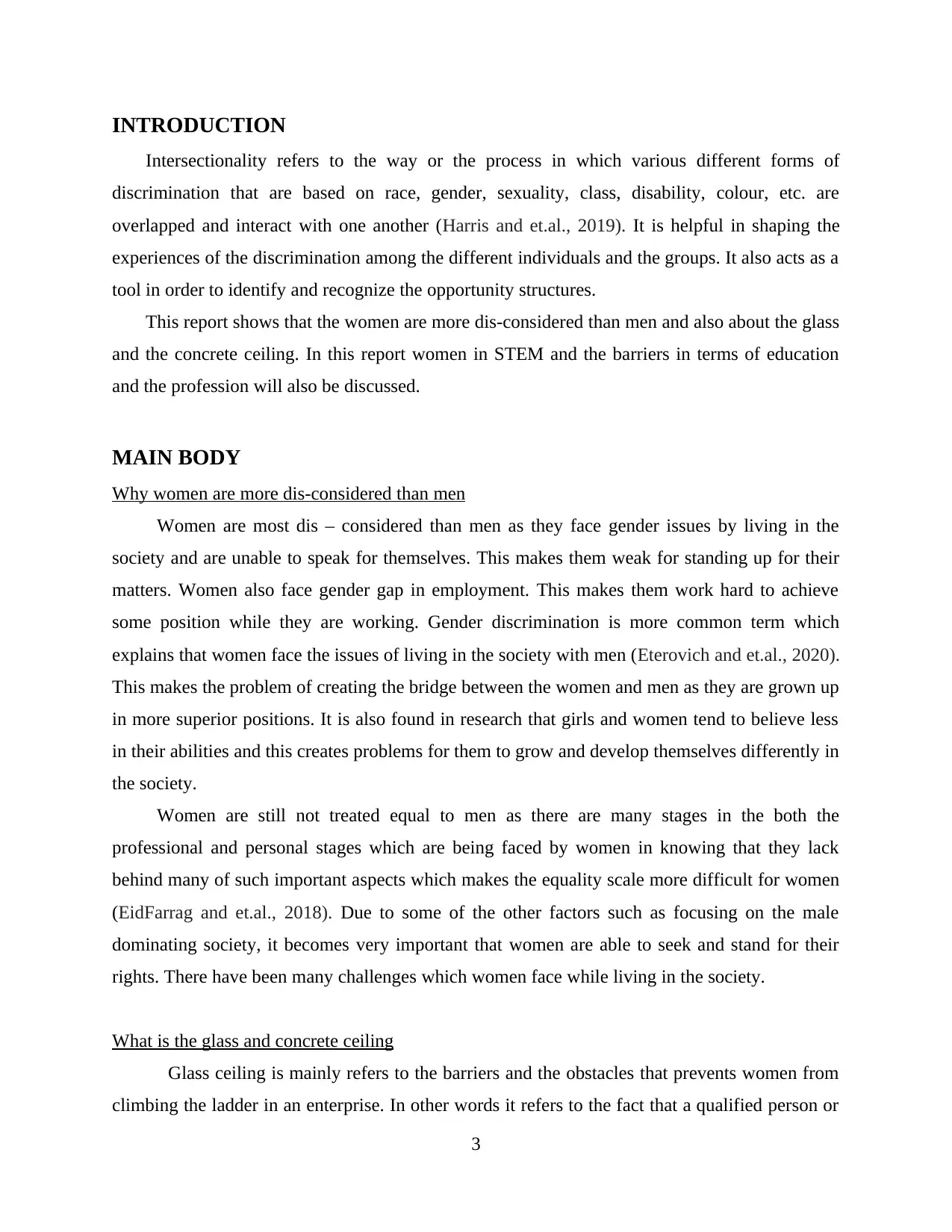
INTRODUCTION
Intersectionality refers to the way or the process in which various different forms of
discrimination that are based on race, gender, sexuality, class, disability, colour, etc. are
overlapped and interact with one another (Harris and et.al., 2019). It is helpful in shaping the
experiences of the discrimination among the different individuals and the groups. It also acts as a
tool in order to identify and recognize the opportunity structures.
This report shows that the women are more dis-considered than men and also about the glass
and the concrete ceiling. In this report women in STEM and the barriers in terms of education
and the profession will also be discussed.
MAIN BODY
Why women are more dis-considered than men
Women are most dis – considered than men as they face gender issues by living in the
society and are unable to speak for themselves. This makes them weak for standing up for their
matters. Women also face gender gap in employment. This makes them work hard to achieve
some position while they are working. Gender discrimination is more common term which
explains that women face the issues of living in the society with men (Eterovich and et.al., 2020).
This makes the problem of creating the bridge between the women and men as they are grown up
in more superior positions. It is also found in research that girls and women tend to believe less
in their abilities and this creates problems for them to grow and develop themselves differently in
the society.
Women are still not treated equal to men as there are many stages in the both the
professional and personal stages which are being faced by women in knowing that they lack
behind many of such important aspects which makes the equality scale more difficult for women
(EidFarrag and et.al., 2018). Due to some of the other factors such as focusing on the male
dominating society, it becomes very important that women are able to seek and stand for their
rights. There have been many challenges which women face while living in the society.
What is the glass and concrete ceiling
Glass ceiling is mainly refers to the barriers and the obstacles that prevents women from
climbing the ladder in an enterprise. In other words it refers to the fact that a qualified person or
3
Intersectionality refers to the way or the process in which various different forms of
discrimination that are based on race, gender, sexuality, class, disability, colour, etc. are
overlapped and interact with one another (Harris and et.al., 2019). It is helpful in shaping the
experiences of the discrimination among the different individuals and the groups. It also acts as a
tool in order to identify and recognize the opportunity structures.
This report shows that the women are more dis-considered than men and also about the glass
and the concrete ceiling. In this report women in STEM and the barriers in terms of education
and the profession will also be discussed.
MAIN BODY
Why women are more dis-considered than men
Women are most dis – considered than men as they face gender issues by living in the
society and are unable to speak for themselves. This makes them weak for standing up for their
matters. Women also face gender gap in employment. This makes them work hard to achieve
some position while they are working. Gender discrimination is more common term which
explains that women face the issues of living in the society with men (Eterovich and et.al., 2020).
This makes the problem of creating the bridge between the women and men as they are grown up
in more superior positions. It is also found in research that girls and women tend to believe less
in their abilities and this creates problems for them to grow and develop themselves differently in
the society.
Women are still not treated equal to men as there are many stages in the both the
professional and personal stages which are being faced by women in knowing that they lack
behind many of such important aspects which makes the equality scale more difficult for women
(EidFarrag and et.al., 2018). Due to some of the other factors such as focusing on the male
dominating society, it becomes very important that women are able to seek and stand for their
rights. There have been many challenges which women face while living in the society.
What is the glass and concrete ceiling
Glass ceiling is mainly refers to the barriers and the obstacles that prevents women from
climbing the ladder in an enterprise. In other words it refers to the fact that a qualified person or
3
⊘ This is a preview!⊘
Do you want full access?
Subscribe today to unlock all pages.

Trusted by 1+ million students worldwide
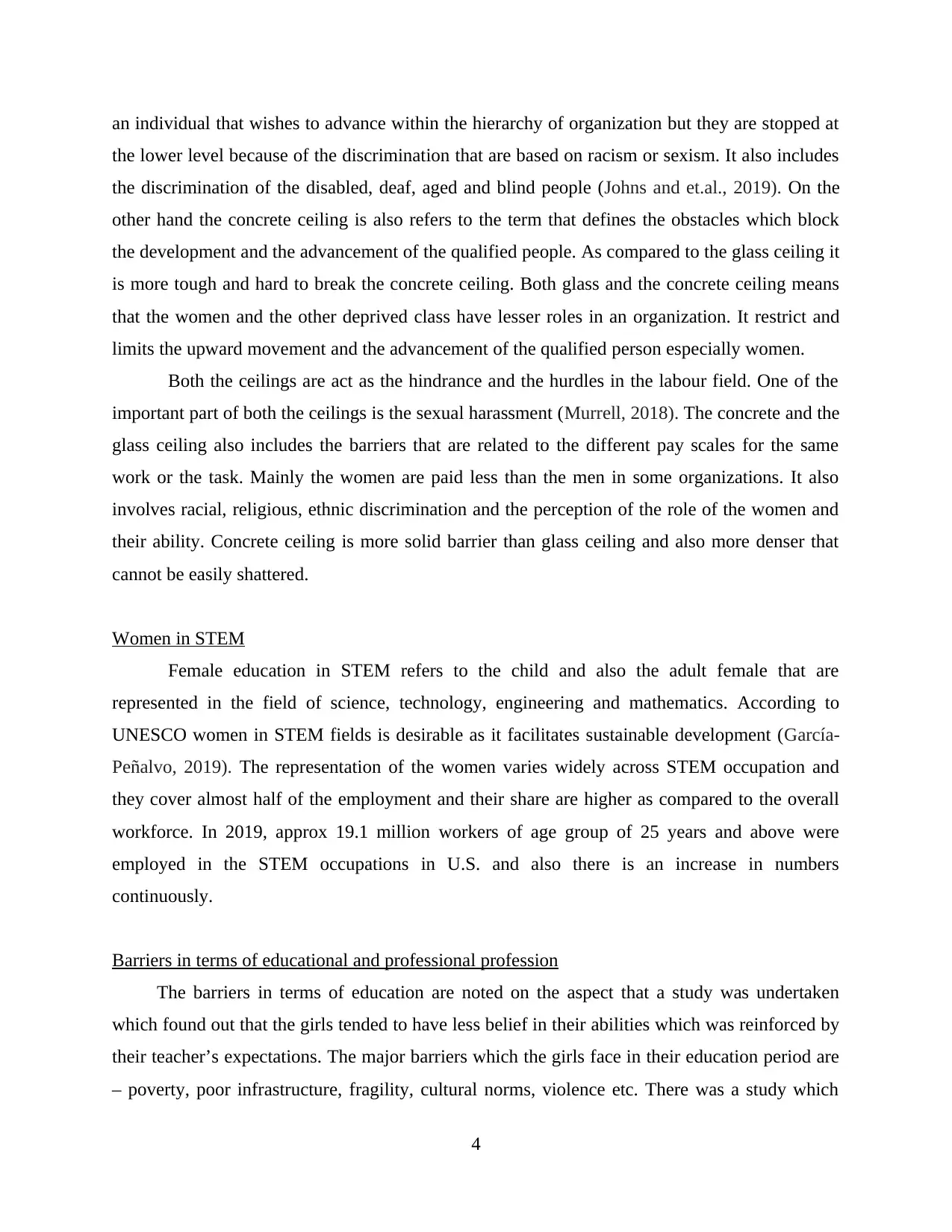
an individual that wishes to advance within the hierarchy of organization but they are stopped at
the lower level because of the discrimination that are based on racism or sexism. It also includes
the discrimination of the disabled, deaf, aged and blind people (Johns and et.al., 2019). On the
other hand the concrete ceiling is also refers to the term that defines the obstacles which block
the development and the advancement of the qualified people. As compared to the glass ceiling it
is more tough and hard to break the concrete ceiling. Both glass and the concrete ceiling means
that the women and the other deprived class have lesser roles in an organization. It restrict and
limits the upward movement and the advancement of the qualified person especially women.
Both the ceilings are act as the hindrance and the hurdles in the labour field. One of the
important part of both the ceilings is the sexual harassment (Murrell, 2018). The concrete and the
glass ceiling also includes the barriers that are related to the different pay scales for the same
work or the task. Mainly the women are paid less than the men in some organizations. It also
involves racial, religious, ethnic discrimination and the perception of the role of the women and
their ability. Concrete ceiling is more solid barrier than glass ceiling and also more denser that
cannot be easily shattered.
Women in STEM
Female education in STEM refers to the child and also the adult female that are
represented in the field of science, technology, engineering and mathematics. According to
UNESCO women in STEM fields is desirable as it facilitates sustainable development (García-
Peñalvo, 2019). The representation of the women varies widely across STEM occupation and
they cover almost half of the employment and their share are higher as compared to the overall
workforce. In 2019, approx 19.1 million workers of age group of 25 years and above were
employed in the STEM occupations in U.S. and also there is an increase in numbers
continuously.
Barriers in terms of educational and professional profession
The barriers in terms of education are noted on the aspect that a study was undertaken
which found out that the girls tended to have less belief in their abilities which was reinforced by
their teacher’s expectations. The major barriers which the girls face in their education period are
– poverty, poor infrastructure, fragility, cultural norms, violence etc. There was a study which
4
the lower level because of the discrimination that are based on racism or sexism. It also includes
the discrimination of the disabled, deaf, aged and blind people (Johns and et.al., 2019). On the
other hand the concrete ceiling is also refers to the term that defines the obstacles which block
the development and the advancement of the qualified people. As compared to the glass ceiling it
is more tough and hard to break the concrete ceiling. Both glass and the concrete ceiling means
that the women and the other deprived class have lesser roles in an organization. It restrict and
limits the upward movement and the advancement of the qualified person especially women.
Both the ceilings are act as the hindrance and the hurdles in the labour field. One of the
important part of both the ceilings is the sexual harassment (Murrell, 2018). The concrete and the
glass ceiling also includes the barriers that are related to the different pay scales for the same
work or the task. Mainly the women are paid less than the men in some organizations. It also
involves racial, religious, ethnic discrimination and the perception of the role of the women and
their ability. Concrete ceiling is more solid barrier than glass ceiling and also more denser that
cannot be easily shattered.
Women in STEM
Female education in STEM refers to the child and also the adult female that are
represented in the field of science, technology, engineering and mathematics. According to
UNESCO women in STEM fields is desirable as it facilitates sustainable development (García-
Peñalvo, 2019). The representation of the women varies widely across STEM occupation and
they cover almost half of the employment and their share are higher as compared to the overall
workforce. In 2019, approx 19.1 million workers of age group of 25 years and above were
employed in the STEM occupations in U.S. and also there is an increase in numbers
continuously.
Barriers in terms of educational and professional profession
The barriers in terms of education are noted on the aspect that a study was undertaken
which found out that the girls tended to have less belief in their abilities which was reinforced by
their teacher’s expectations. The major barriers which the girls face in their education period are
– poverty, poor infrastructure, fragility, cultural norms, violence etc. There was a study which
4
Paraphrase This Document
Need a fresh take? Get an instant paraphrase of this document with our AI Paraphraser
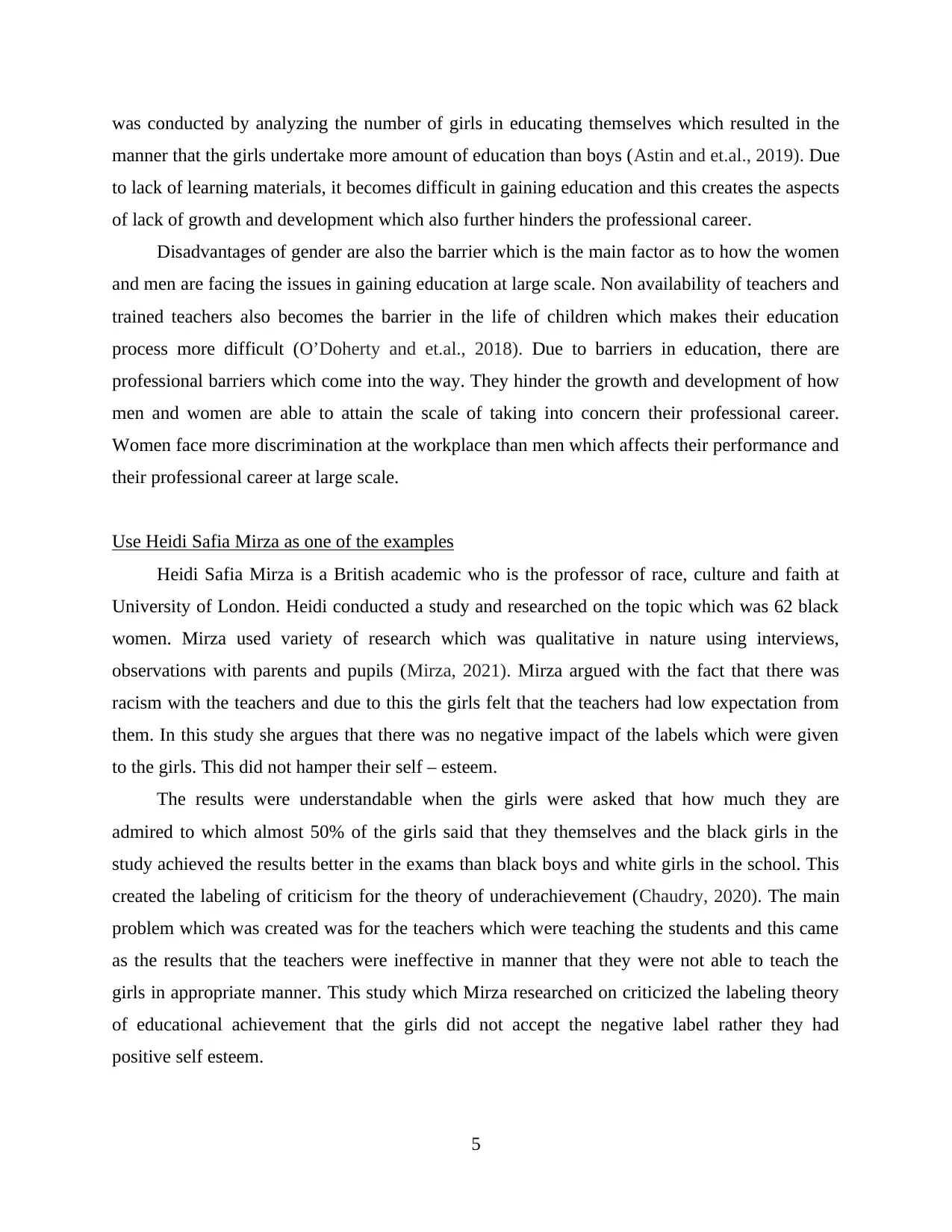
was conducted by analyzing the number of girls in educating themselves which resulted in the
manner that the girls undertake more amount of education than boys (Astin and et.al., 2019). Due
to lack of learning materials, it becomes difficult in gaining education and this creates the aspects
of lack of growth and development which also further hinders the professional career.
Disadvantages of gender are also the barrier which is the main factor as to how the women
and men are facing the issues in gaining education at large scale. Non availability of teachers and
trained teachers also becomes the barrier in the life of children which makes their education
process more difficult (O’Doherty and et.al., 2018). Due to barriers in education, there are
professional barriers which come into the way. They hinder the growth and development of how
men and women are able to attain the scale of taking into concern their professional career.
Women face more discrimination at the workplace than men which affects their performance and
their professional career at large scale.
Use Heidi Safia Mirza as one of the examples
Heidi Safia Mirza is a British academic who is the professor of race, culture and faith at
University of London. Heidi conducted a study and researched on the topic which was 62 black
women. Mirza used variety of research which was qualitative in nature using interviews,
observations with parents and pupils (Mirza, 2021). Mirza argued with the fact that there was
racism with the teachers and due to this the girls felt that the teachers had low expectation from
them. In this study she argues that there was no negative impact of the labels which were given
to the girls. This did not hamper their self – esteem.
The results were understandable when the girls were asked that how much they are
admired to which almost 50% of the girls said that they themselves and the black girls in the
study achieved the results better in the exams than black boys and white girls in the school. This
created the labeling of criticism for the theory of underachievement (Chaudry, 2020). The main
problem which was created was for the teachers which were teaching the students and this came
as the results that the teachers were ineffective in manner that they were not able to teach the
girls in appropriate manner. This study which Mirza researched on criticized the labeling theory
of educational achievement that the girls did not accept the negative label rather they had
positive self esteem.
5
manner that the girls undertake more amount of education than boys (Astin and et.al., 2019). Due
to lack of learning materials, it becomes difficult in gaining education and this creates the aspects
of lack of growth and development which also further hinders the professional career.
Disadvantages of gender are also the barrier which is the main factor as to how the women
and men are facing the issues in gaining education at large scale. Non availability of teachers and
trained teachers also becomes the barrier in the life of children which makes their education
process more difficult (O’Doherty and et.al., 2018). Due to barriers in education, there are
professional barriers which come into the way. They hinder the growth and development of how
men and women are able to attain the scale of taking into concern their professional career.
Women face more discrimination at the workplace than men which affects their performance and
their professional career at large scale.
Use Heidi Safia Mirza as one of the examples
Heidi Safia Mirza is a British academic who is the professor of race, culture and faith at
University of London. Heidi conducted a study and researched on the topic which was 62 black
women. Mirza used variety of research which was qualitative in nature using interviews,
observations with parents and pupils (Mirza, 2021). Mirza argued with the fact that there was
racism with the teachers and due to this the girls felt that the teachers had low expectation from
them. In this study she argues that there was no negative impact of the labels which were given
to the girls. This did not hamper their self – esteem.
The results were understandable when the girls were asked that how much they are
admired to which almost 50% of the girls said that they themselves and the black girls in the
study achieved the results better in the exams than black boys and white girls in the school. This
created the labeling of criticism for the theory of underachievement (Chaudry, 2020). The main
problem which was created was for the teachers which were teaching the students and this came
as the results that the teachers were ineffective in manner that they were not able to teach the
girls in appropriate manner. This study which Mirza researched on criticized the labeling theory
of educational achievement that the girls did not accept the negative label rather they had
positive self esteem.
5
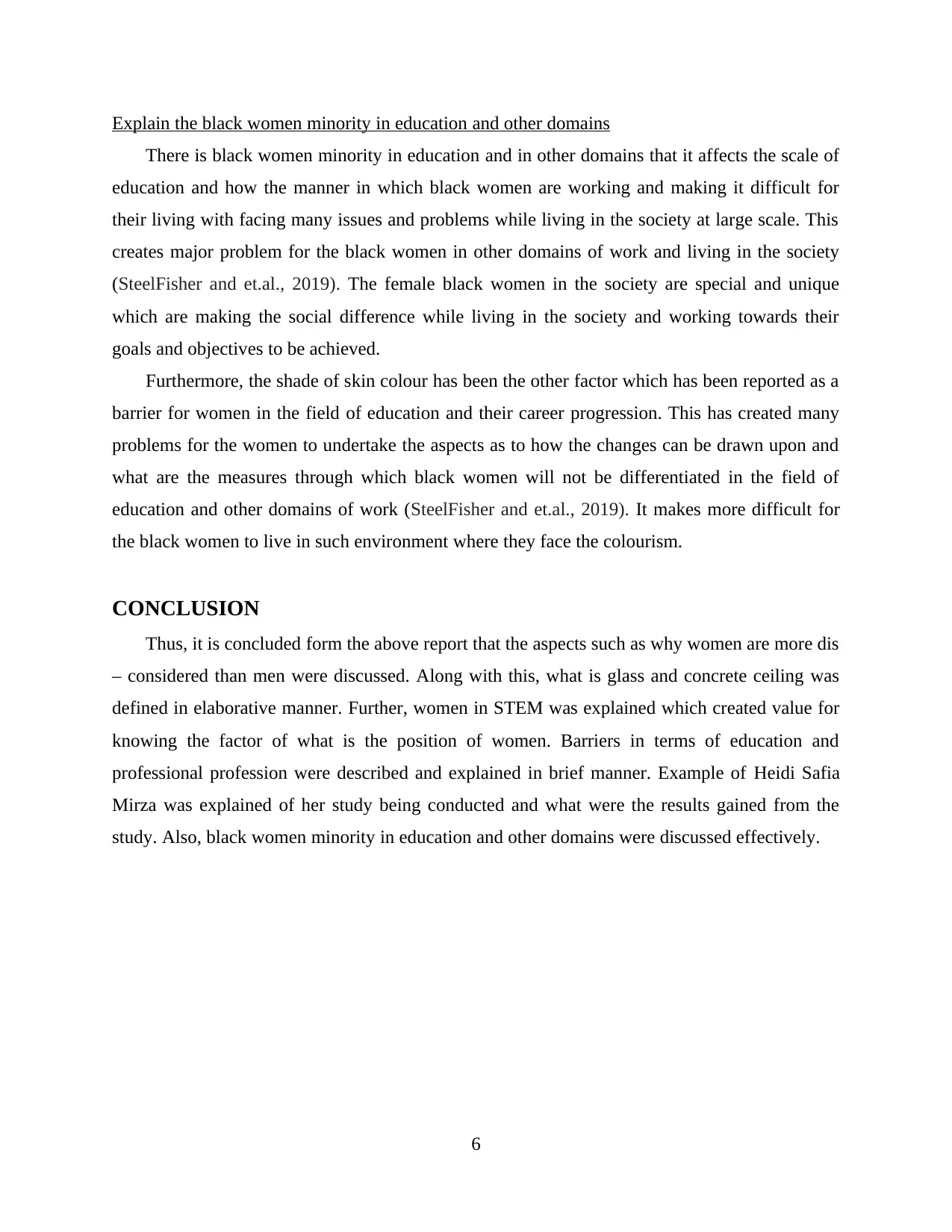
Explain the black women minority in education and other domains
There is black women minority in education and in other domains that it affects the scale of
education and how the manner in which black women are working and making it difficult for
their living with facing many issues and problems while living in the society at large scale. This
creates major problem for the black women in other domains of work and living in the society
(SteelFisher and et.al., 2019). The female black women in the society are special and unique
which are making the social difference while living in the society and working towards their
goals and objectives to be achieved.
Furthermore, the shade of skin colour has been the other factor which has been reported as a
barrier for women in the field of education and their career progression. This has created many
problems for the women to undertake the aspects as to how the changes can be drawn upon and
what are the measures through which black women will not be differentiated in the field of
education and other domains of work (SteelFisher and et.al., 2019). It makes more difficult for
the black women to live in such environment where they face the colourism.
CONCLUSION
Thus, it is concluded form the above report that the aspects such as why women are more dis
– considered than men were discussed. Along with this, what is glass and concrete ceiling was
defined in elaborative manner. Further, women in STEM was explained which created value for
knowing the factor of what is the position of women. Barriers in terms of education and
professional profession were described and explained in brief manner. Example of Heidi Safia
Mirza was explained of her study being conducted and what were the results gained from the
study. Also, black women minority in education and other domains were discussed effectively.
6
There is black women minority in education and in other domains that it affects the scale of
education and how the manner in which black women are working and making it difficult for
their living with facing many issues and problems while living in the society at large scale. This
creates major problem for the black women in other domains of work and living in the society
(SteelFisher and et.al., 2019). The female black women in the society are special and unique
which are making the social difference while living in the society and working towards their
goals and objectives to be achieved.
Furthermore, the shade of skin colour has been the other factor which has been reported as a
barrier for women in the field of education and their career progression. This has created many
problems for the women to undertake the aspects as to how the changes can be drawn upon and
what are the measures through which black women will not be differentiated in the field of
education and other domains of work (SteelFisher and et.al., 2019). It makes more difficult for
the black women to live in such environment where they face the colourism.
CONCLUSION
Thus, it is concluded form the above report that the aspects such as why women are more dis
– considered than men were discussed. Along with this, what is glass and concrete ceiling was
defined in elaborative manner. Further, women in STEM was explained which created value for
knowing the factor of what is the position of women. Barriers in terms of education and
professional profession were described and explained in brief manner. Example of Heidi Safia
Mirza was explained of her study being conducted and what were the results gained from the
study. Also, black women minority in education and other domains were discussed effectively.
6
⊘ This is a preview!⊘
Do you want full access?
Subscribe today to unlock all pages.

Trusted by 1+ million students worldwide
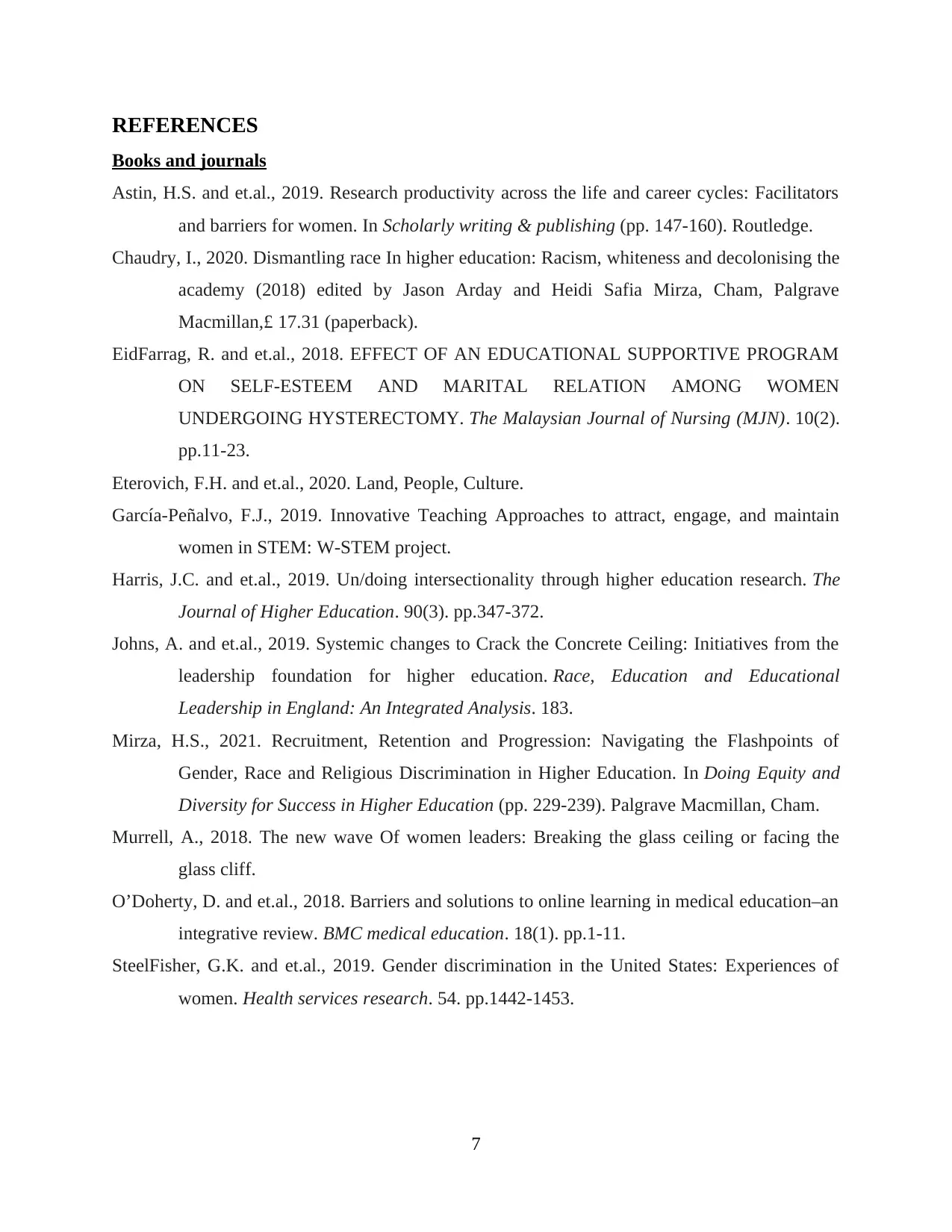
REFERENCES
Books and journals
Astin, H.S. and et.al., 2019. Research productivity across the life and career cycles: Facilitators
and barriers for women. In Scholarly writing & publishing (pp. 147-160). Routledge.
Chaudry, I., 2020. Dismantling race In higher education: Racism, whiteness and decolonising the
academy (2018) edited by Jason Arday and Heidi Safia Mirza, Cham, Palgrave
Macmillan,£ 17.31 (paperback).
EidFarrag, R. and et.al., 2018. EFFECT OF AN EDUCATIONAL SUPPORTIVE PROGRAM
ON SELF-ESTEEM AND MARITAL RELATION AMONG WOMEN
UNDERGOING HYSTERECTOMY. The Malaysian Journal of Nursing (MJN). 10(2).
pp.11-23.
Eterovich, F.H. and et.al., 2020. Land, People, Culture.
García-Peñalvo, F.J., 2019. Innovative Teaching Approaches to attract, engage, and maintain
women in STEM: W-STEM project.
Harris, J.C. and et.al., 2019. Un/doing intersectionality through higher education research. The
Journal of Higher Education. 90(3). pp.347-372.
Johns, A. and et.al., 2019. Systemic changes to Crack the Concrete Ceiling: Initiatives from the
leadership foundation for higher education. Race, Education and Educational
Leadership in England: An Integrated Analysis. 183.
Mirza, H.S., 2021. Recruitment, Retention and Progression: Navigating the Flashpoints of
Gender, Race and Religious Discrimination in Higher Education. In Doing Equity and
Diversity for Success in Higher Education (pp. 229-239). Palgrave Macmillan, Cham.
Murrell, A., 2018. The new wave Of women leaders: Breaking the glass ceiling or facing the
glass cliff.
O’Doherty, D. and et.al., 2018. Barriers and solutions to online learning in medical education–an
integrative review. BMC medical education. 18(1). pp.1-11.
SteelFisher, G.K. and et.al., 2019. Gender discrimination in the United States: Experiences of
women. Health services research. 54. pp.1442-1453.
7
Books and journals
Astin, H.S. and et.al., 2019. Research productivity across the life and career cycles: Facilitators
and barriers for women. In Scholarly writing & publishing (pp. 147-160). Routledge.
Chaudry, I., 2020. Dismantling race In higher education: Racism, whiteness and decolonising the
academy (2018) edited by Jason Arday and Heidi Safia Mirza, Cham, Palgrave
Macmillan,£ 17.31 (paperback).
EidFarrag, R. and et.al., 2018. EFFECT OF AN EDUCATIONAL SUPPORTIVE PROGRAM
ON SELF-ESTEEM AND MARITAL RELATION AMONG WOMEN
UNDERGOING HYSTERECTOMY. The Malaysian Journal of Nursing (MJN). 10(2).
pp.11-23.
Eterovich, F.H. and et.al., 2020. Land, People, Culture.
García-Peñalvo, F.J., 2019. Innovative Teaching Approaches to attract, engage, and maintain
women in STEM: W-STEM project.
Harris, J.C. and et.al., 2019. Un/doing intersectionality through higher education research. The
Journal of Higher Education. 90(3). pp.347-372.
Johns, A. and et.al., 2019. Systemic changes to Crack the Concrete Ceiling: Initiatives from the
leadership foundation for higher education. Race, Education and Educational
Leadership in England: An Integrated Analysis. 183.
Mirza, H.S., 2021. Recruitment, Retention and Progression: Navigating the Flashpoints of
Gender, Race and Religious Discrimination in Higher Education. In Doing Equity and
Diversity for Success in Higher Education (pp. 229-239). Palgrave Macmillan, Cham.
Murrell, A., 2018. The new wave Of women leaders: Breaking the glass ceiling or facing the
glass cliff.
O’Doherty, D. and et.al., 2018. Barriers and solutions to online learning in medical education–an
integrative review. BMC medical education. 18(1). pp.1-11.
SteelFisher, G.K. and et.al., 2019. Gender discrimination in the United States: Experiences of
women. Health services research. 54. pp.1442-1453.
7
1 out of 7
Related Documents
Your All-in-One AI-Powered Toolkit for Academic Success.
+13062052269
info@desklib.com
Available 24*7 on WhatsApp / Email
![[object Object]](/_next/static/media/star-bottom.7253800d.svg)
Unlock your academic potential
Copyright © 2020–2025 A2Z Services. All Rights Reserved. Developed and managed by ZUCOL.





